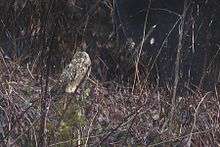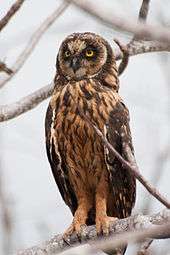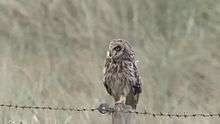Short-eared owl
| Short-eared owl | |
|---|---|
 | |
| In Piraju, São Paulo, Brazil | |
| Scientific classification | |
| Kingdom: | Animalia |
| Phylum: | Chordata |
| Class: | Aves |
| Order: | Strigiformes |
| Family: | Strigidae |
| Subfamily: | Asioninae[2] |
| Genus: | Asio |
| Species: | A. flammeus |
| Binomial name | |
| Asio flammeus (Pontoppidan, 1763) | |
 | |
| Synonyms | |
|
Asio accipitrinus | |
_Photograph_By_Shantanu_Kuveskar.jpg)

The short-eared owl (Asio flammeus) is a species of typical owl (family Strigidae). Owls belonging to genus Asio are known as the eared owls, as they have tufts of feathers resembling mammalian ears. These "ear" tufts may or may not be visible. Asio flammeus will display its tufts when in a defensive pose, although its very short tufts are usually not visible. The short-eared owl is found in open country and grasslands. The scientific name is from Latin. The genus name Asio is a type of eared owl, and flammeus means "flame-coloured".[3]
Description
The short-eared owl is a medium-sized owl measuring 34–43 cm (13–17 in) in length and weighing 206–475 g (7.3–16.8 oz).[4] It has large eyes, a big head, a short neck, and broad wings. Its bill is short, strong, hooked and black. Its plumage is mottled tawny to brown with a barred tail and wings. The upper breast is significantly streaked.[5] Its flight is characteristically floppy due to its irregular wingbeats. The short-eared owl may also be described as "moth or bat-like" in flight.[6] Wingspans range from 85 to 110 cm (33 to 43 in).[7] Females are slightly larger than males. The yellow-orange eyes of A. flammeus are exaggerated by black rings encircling each eye, giving the appearance of them wearing mascara, and large, whitish disks of plumage surrounding the eyes like a mask.
Separation from long-eared owl
Over much of its range, short-eared owls occurs with the similar-looking long-eared owl. At rest, the ear-tufts of long-eared owl serve to easily distinguish the two (although long-eared owl can sometimes hold its ear-tufts flat). The iris-colour differs: yellow in short-eared, and orange in long-eared, and the black surrounding the eyes is vertical on long-eared, and horizontal on short-eared. Overall the short-eared tends to be a paler, sandier bird than the long-eared. There are a number of other ways in which the two species the differ which are best seen when they are flying: a) short-eared often has a broad white band along the rear edge of the wing, which is not shown by long-eared; b) on the upperwing, short-eared owls' primary-patches are usually paler and more obvious; c) the band on the upper side of short-eared owl's tail are usually bolder than those of long-eared; d) short-eared's innermost secondaries are often dark-marked, contrasting with the rest of the underwing; e) the long-eared owl has streaking throughout its underparts whereas on short-eared the streaking ends at the breast; f) the dark markings on the underside of the tips of the longest primaries are bolder on short-eared owl; g) the upperparts are coarsely blotched, whereas on long-eared they are more finely marked. The short-eared owl also differs structurally from the long-eared, having longer, slimmer wings: the long-eared owl has wings shaped more like those of a tawny owl.[8] The long-eared owl generally has different habitat preferences from the short-eared, most often being found concealed in areas with dense wooded thickets. The short-eared owl is often most regularly seen flying about in early morning or late day as it hunts over open habitats.
Subspecies

As of 2009, there are ten recognized subspecies of the short-eared owl:[2][9]
- A. f. bogotensis – Chapman, 1915: found in Colombia, Ecuador and northwestern Peru
- A. f. domingensis – (Statius Müller, 1776): found on Hispaniola
- A. f. flammeus – (Pontoppidan, 1763): nominate, found in North America, Europe, northern Africa and northern Asia
- A. f. galapagoensis – (Gould, 1837): Galápagos Islands[10]
- A. f. pallidicaudus – Friedmann, 1949: found in Venezuela, Guyana and Suriname
- A. f. ponapensis – Mayr, 1933: found on east Caroline Island
- A. f. portoricensis – Ridgway, 1882: found in Puerto Rico
- A. f. sandwichensis – (A. Bloxam, 1827): Pueo or Hawaiian short-eared owl - found in the Hawaiian Islands[11]
- A. f. sanfordi – Bangs, 1919: found on the Falkland Islands
- A. f. suinda – (Vieillot, 1817): found from southern Peru and southern Brazil to Tierra del Fuego
Some authorities recognize a further subspecies:[9]
- A. f. cubensis – Garrido, 2007: found in Cuba
Range
The short-eared owl occurs on all continents except Antarctica and Australia; thus it has one of the most widespread distributions of any bird. A. flammeus breeds in Europe, Asia, North and South America, the Caribbean, Hawaii and the Galápagos Islands. It is partially migratory, moving south in winter from the northern parts of its range. The short-eared owl is known to relocate to areas of higher rodent populations.[12] It will also wander nomadically in search of better food supplies during years when vole populations are low. (See a map of the short-eared owl's distribution across the New World.)
Behaviour
Nesting and reproduction
Sexual maturity is attained at one year. Breeding season in the northern hemisphere lasts from March to June, peaking in April. During this time these owls may gather in flocks. During breeding season, the males make great spectacles of themselves in flight to attract females. The male swoops down over the nest flapping its wings in a courtship display.[12] These owls are generally monogamous.
The short-eared owl nests on the ground in prairie, tundra, savanna, or meadow habitats. Nests are concealed by low vegetation, and may be lightly lined by weeds, grass, or feathers.[12] Approximately 4 to 7 white eggs are found in a typical clutch, but clutch size can reach up to a dozen eggs in years when voles are abundant. There is one brood per year. The eggs are incubated mostly by the female for 21–37 days. Offspring fledge at a little over four weeks. This owl is known to lure predators away from its nest by appearing to have a crippled wing.[5]
Diet and foraging habits
_(1).jpg)
.jpg)
Hunting occurs mostly at night, but this owl is known to be diurnal and crepuscular as well. Its daylight hunting seems to coincide with the high-activity periods of voles, its preferred prey.[13] It tends to fly only feet above the ground in open fields and grasslands until swooping down upon its prey feet-first.[5] Several owls may hunt over the same open area.[14] Its food consists mainly of rodents, especially voles, but it will eat other small mammals such as mice, ground squirrels, shrews, rats, bats, muskrats and moles. It will also occasionally predate smaller birds, especially when near sea-coasts and adjacent wetlands at which time they attack shorebirds, terns and small gulls and seabirds with semi-regularity. Avian prey is more infrequently preyed on inland and centers on passerines such as larks, icterids, starlings, tyrant flycatchers and pipits. Insects supplement the diet and short-eared owls may prey on roaches, grasshoppers, beetles, katydids and caterpillars. Competition can be fierce in North America with the northern harrier, with which the owl shares similar habitat and prey preferences. Both species will readily harass the other when prey is caught.[15]
Pellets
Because of the high pH in the stomach of owls they have a reduced ability to digest bone and other hard parts, they eject pellets containing the remains of their prey.[16]
Calls
Short-eared owls have a scratchy bark-like call. Raspy waowk, waowk, waowk or toot-toot-toot-toot-toot sounds are common. A loud eeee-yerp is also heard on breeding grounds. However, short-eared owls are silent on the wintering grounds.[5]
Conservation status
It is listed as declining in the southern portion of its US range. It is common in the northern portion of its breeding range.[4]
It is listed as endangered in New Mexico. Its appearance at the Calverton Executive Airpark on Long Island has prompted the New York State Department of Environmental Conservation to take the lead on ruling whether a massive redevelopment of the airport will receive the necessary environmental permits.[4]
References
- ↑ BirdLife International (2012). "Asio flammeus". IUCN Red List of Threatened Species. Version 2013.2. International Union for Conservation of Nature. Retrieved 26 November 2013.
- 1 2 "Asio flammeus". ITIS Report. Integrated Taxonomic Information System. Retrieved 16 February 2009.
- ↑ Jobling, James A (2010). The Helm Dictionary of Scientific Bird Names. London: Christopher Helm. pp. 57, 160. ISBN 978-1-4081-2501-4.
- 1 2 3 "Short-eared Owl". All About Birds. Cornell Lab of Ornithology.
- 1 2 3 4 Alsop, Fred J. (2001). Birds of North America: Eastern Region. New York, NY: DK Publishing, Inc. ISBN 978-0789471567.
- ↑ "Short-eared Owl Fact Sheet". New York State Department of Environmental Conservation.
- ↑ Doan, N. (1999). "Asio flammeus" (On-line)". Animal Diversity Web. Retrieved 8 November 2014.
- ↑ Harris, Alan; Tucker, Laurel; Vinicombe, Keith (1989). The MacMillan Field Guide to Bird Identification. pp. 147–149. ISBN 978-0333589403(reference covers whole paragraph)
- 1 2 Gill, F.; Donsker, D., eds. (2014). "IOC World Bird List (v 4.4)". doi:10.14344/IOC.ML.4.4. Retrieved 8 November 2014.
- ↑ Kricher, John C. (2006). Galápagos: A Natural History. Princeton University Press. p. 130. ISBN 978-0-691-12633-3.
- ↑ "Pueo or Hawaiian Short-eared Owl" (PDF). Hawaii’s Comprehensive Wildlife Conservation Strategy. State of Hawaii, Division of Forestry and Wildlife. 1 October 2005. Retrieved 16 February 2009.
- 1 2 3 Ehrlich, Paul R.; Dobkin, David S.; Wheye, Darryl (1988). The Birder's Handbook: A Field Guide to the Natural History of North American Birds. New York, NY: Simon & Schuster Inc.
- ↑ Reynolds, Peter; Gorman, Martyn L. (28 February 2006). "The timing of hunting in short-eared owls (Asio flammeus) in relation to the activity patterns of Orkney voles (Microtus arvalis orcadensis)". Journal of Zoology. London: Blackwell Publishing. 247 (3): 371–79. doi:10.1111/j.1469-7998.1999.tb01000.x. ISSN 1469-7998. (subscription required (help)).
- ↑ Kaufman, Kenn (2000). Kaufman Field Guide to Birds of North America. New York, NY: Houghton Mifflin Co.
- ↑ "Short-eared Owl - Asio Flammeus". The Owl Pages.
- ↑ Smiddy, P. (2013). "The characteristics of Irish Short-eared Owl (Asio flammeus) pellets". Ir Nat. J. 33: 8–13.
Identification
- Davis, A.H.; Prytherch, R.J. (1976). "Field identification of Long-eared and Short-eared Owls". British Birds. 69: 281–287.
- Kemp, J.B. (1982). "Field identification of Long-eared and Short-eared Owls". British Birds. 75 (5): 227.
- Robertson, Iain S. (1982). "Field identification of Long-eared and Short-eared Owls". British Birds. 75 (5): 227–229.
- Kemp, J.B. (1982). "Tail-lengths of Long-eared and Short-eared Owls". British Birds. 75 (5): 230.
External links
| Wikimedia Commons has media related to Asio flammeus. |
| Wikispecies has information related to: Asio flammeus |
- Short-eared Owl - Asio flammeus - USGS Patuxent Bird Identification InfoCenter
- "Short-eared owl media". Internet Bird Collection.
- Riverhead, NY News Review article about the appearance of short-eared owls at EPCAL
- Ageing and sexing (PDF; 3.7 MB) by Javier Blasco-Zumeta & Gerd-Michael Heinze
- BirdLife species factsheet for Asio flammeus
- "Asio flammeus". Avibase.

- Short-eared owl photo gallery at VIREO (Drexel University)
- Interactive range map of Asio flammeus at IUCN Red List maps
- Audio recordings of Short-eared owl on Xeno-canto.

